Vein Treatments
Are you experiencing leg pain or discomfort due to varicose or spider veins?
If so, you could be suffering from venous reflux disease, a circulatory condition experienced by 25 million Americans.
Venous reflux, also called venous insufficiency, develops when the valves within a vein weaken and are unable to push blood upwards to the heart. These valves leak and allow blood to flow backwards within the vein and pool. One of the most common physical conditions of venous reflux is varicose veins.
In the past, patients with venous reflux would have to undergo long and painful surgeries to correct the condition. Now, patients are offered an array of minimally invasive treatments to correct their vein disease.
What are varicose veins?
In a properly functioning vein, one-way valves keep blood flowing upwards against the force of gravity. The muscles of the leg help push the blood towards the heart for recirculation. When the valves are weakened and malfunction they are unable to close properly, allowing the blood to flow backwards and pool in the veins. This pooling causes increased pressure, swelling and twisting of the veins, known as varicose veins.
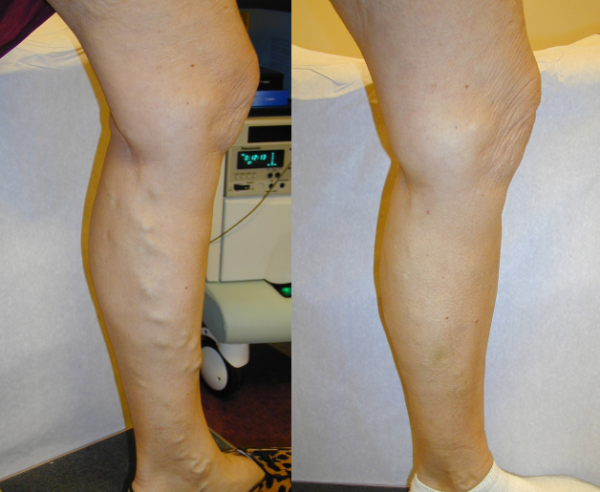 |
Varicose Veins- prior to treatment and after treatment
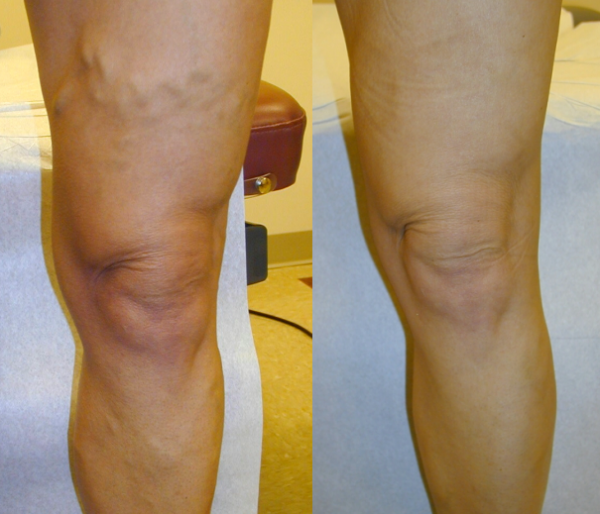 |
Varicose veins are known for their distinctive blue color and rope-like, bulging appearance at the surface of the skin, primarily in the legs. The incompetent vein causes blood to flow the wrong way down a vein, resulting in a buildup of pressure, often causing severe leg pain.
There are a series of factors that can trigger the onset of varicose veins including hormones, pregnancy, obesity, prolonged standing or aging. Varicose veins are hereditary and can affect both women and men.
Symptoms of varicose veins may include (but are not limited to):
- Aching and heaviness
- Ankle swelling, especially in evening
- Redness, dryness and itchiness of the skin
- Leg pain worsened by prolonged sitting or standing
- A brownish-blue discoloration near the affected veins
Varicose veins are diagnosed by performing a physical examination and ultrasound test. The treatments to eliminate varicose veins have improved dramatically in recent years. Current treatment options offer minimally invasive techniques, little down time and long term results.
Spider veins?
Spider veins, a mild form of varicose veins, are very small, thin blood vessels close to the skins surface. The vein walls become weak over time and swell. The red, blue or purple dilated vessels can be found on the thighs, calves, and ankles.
The primary factors contributing to the development of spider veins are heredity, hormones, weight gain, pregnancy and aging. Spider veins are more common in women, but can also develop in men. Pain associated with spider veins is typically less severe than with larger varicose veins, but some discomfort may occur.
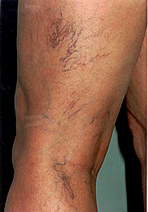 |
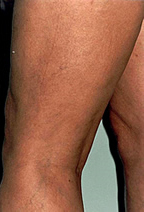 |
|
| Spider Veins - Prior to treatment | After treatment |
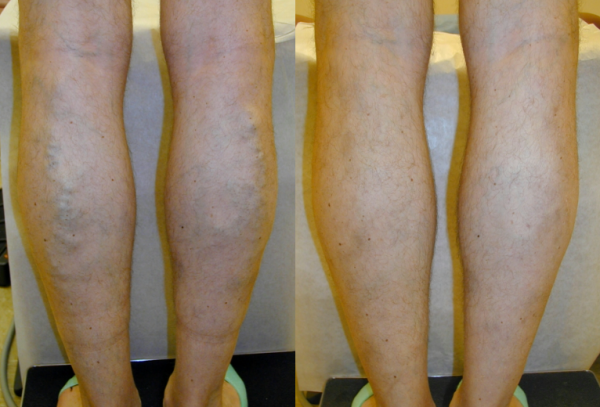 |
Prior to treatment and after treatment
Vein Treatment Services
The Vein Center has state of the art, non-surgical treatment options for all types of venous disorders. The procedures are done in the office, require no down time, and provide excellent long term results. Prior to treatment, an individualized course of action is developed for each patient, accounting for their individual medical needs.
Laser/ Radiofrequency Vein Ablation
Laser/Radiofrequency Vein Ablation, is a minimally-invasive procedure for treating varicose veins. Energy is applied to the vein, causing it to collapse and eventually disappear.
The Laser Vein Ablation Procedure
Venous ablation is a minimally-invasive, outpatient procedure. A thin fiber is inserted directly into the vein, using imaging guidance. The energy heats the vein walls causing them to shrink and close. Overtime, the treated vein will disappear. The procedure is relatively painless, but a small amount of local anesthetic is used. Vein ablation causes no scarring and patients experience rapid healing and immediate relief from symptoms. Following the procedure patients are encouraged to walk and resume daily activities.
Benefits Of Endovenous Laser/ Radiofrequency Treatment
- No hospitalization required
- Treatment time is less than one hour
- Immediate relief from vein symptoms
- Minimal discomfort during the procedure
Ambulatory Phlebectomy
Ambulatory Phlebectomy is a minimally-invasive procedure used to remove dilated veins through tiny incisions in the skin. Ambulatory phlebectomy is designed to treat varicose veins in combination with other superficial vein treatment methods.
The Ambulatory Phlebectomy Procedure
Prior to an ambulatory phlebectomy procedure the veins being treated are injected with an anesthetic solution to numb the vein and reduce post procedure bleeding. Tiny incisions are made over the veins and using a phlebectomy hook, the veins are then extracted through the incision. Following treatment stitches are rarely required and scarring is minimal or non-existent.
Benefits Of Ambulatory Phlebectomy Treatment
- No scarring
- High success rate
- Short recovery time
- Decreased risk of reoccurrence
- Excellent cosmetic results treating varicose veins
Sclerotherapy
Sclerotherapy treatment is used for the treatment of spider veins. Veins are injected with a chemical which irritates the vein’s lining, making it swell, harden and fade over time. Following treatment the cosmetic appearance of the leg is markedly improved.
The Sclerotherapy Procedure
Sclerotherapy treatment is done using a small needle to inject a chemical sclerosant into the veins. The solution cases an irritation of the vein causing it to close. The treated vein will then harden and fade away with time.
In the majority of cases one to three treatments are required to achieve the desired results. For more severe cases, or to treat many small varicose and spider veins, more treatment sessions may be required. Treatment sessions last approximately 15 minutes, depending on the number of veins being treated. Treatment sessions are spaced in four week intervals.
Benefits Sclerotherapy Treatment
- Outpatient procedure
- No anesthesia required
- Multiple treatment sessions allow for best results
- Patients are allowed and encouraged to return to physical activity following procedure
- Rapid improvement in the cosmetic appearance of the leg
Conservative Therapy
Conservative vein therapy refers to multiple non-surgical treatment methods which are used instead of, or in conjunction with clinical treatments. Conservative treatment techniques often include anti-inflammatory medications or medical-grade compression stockings. In addition to conservative treatment options, lifestyle changes may be effective in managing symptoms.
Conservative therapy will not eliminate diseased veins, however it can slow the deterioration caused by venous disease and significantly improve symptoms. Typically, insurance providers will require a period of conservative therapy prior to approving further clinical treatment options.


